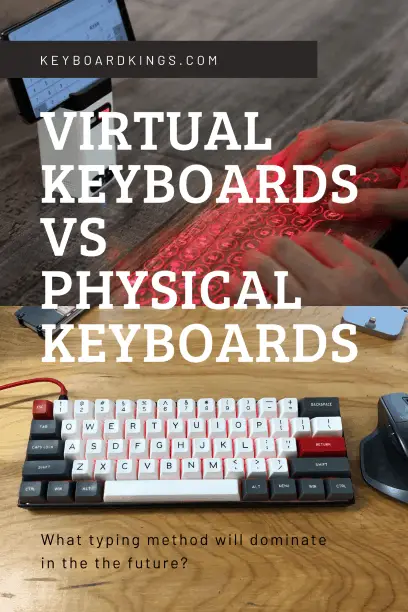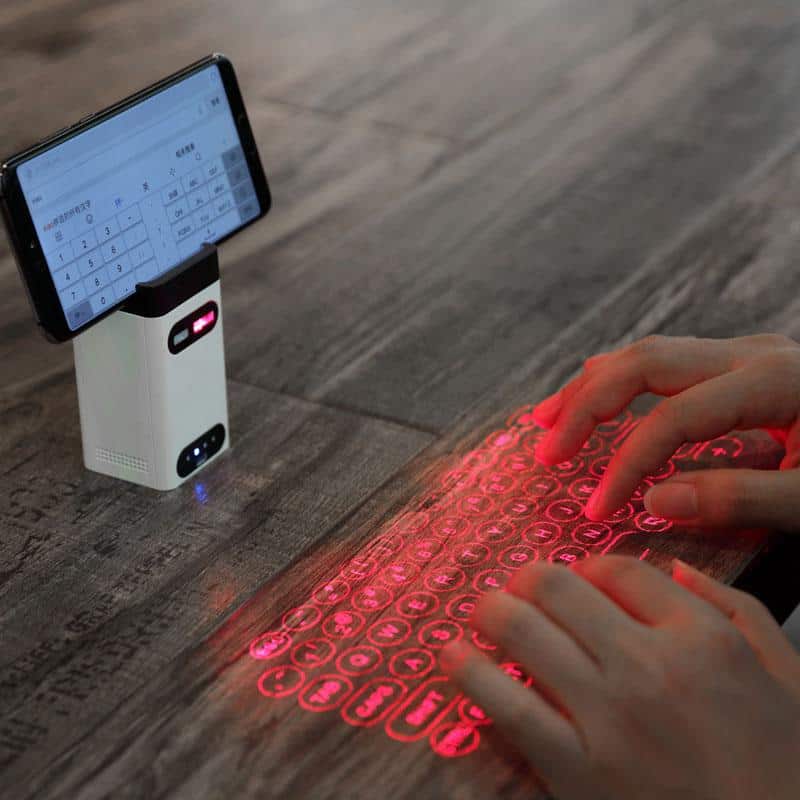Physical keyboards have been around for decades, however, virtual keyboards have just made their way into the technological circuit around 25 or so years ago.
Both have their own pros and cons and both have generally the same purpose – inputting characters. The question is, which one of these will dominate in the future?
There is a community of keyboard enthusiasts who love building and collecting keyboards, so there will always be those who never make the switch. However, with technology becoming more and more advanced, it’s not too far off to think that one day, virtual keyboards will dominate the marketplace.
In this article, we’re going to talk about what a virtual and physical keyboard is, how both of them differ from each other and which one would be more efficient and better for the future.
Table of Contents
The Evolution of the Physical Keyboard

The physical keyboard was invented in the early 70s. The generic keyboard was designed as an electronic device that was used to input signals to the output screen of the computer.
However, if you take a look at the modern keyboards, you’ll see that there have been major changes made to the design and functionalities of the physical keyboard.
In the past couple of decades, the basic keyboard has gone through an immense number of upgrades completely evolving it from a simple input device to a technologically advanced highly function input device.
Changes Made to the Physical Keyboard over the Years
If you want to know what kind of changes the basic keyboard has gone through, we’ve created a list of different kinds of highly functioning keyboards that are available right now in the market to give you a point of reference.
Mechanical Keyboards
Using springs for each button making the typing experience incredibly satisfactory for the user, mechanical keyboards are the most common type of physical keyboards nowadays.
Dual Input Keyboards
In order to cater to the typing needs of bi-lingual users, keyboards that allow dual languages, English, and one other, can be used for different input purposes.
Wireless Keyboards
To make input easier and the ability to type simpler, using Bluetooth technology, physical keyboards were also given the ability to communicate wirelessly with the computers.
Membrane Keyboards
Using a single membrane and not individual keys for each of the buttons, membrane keyboards are flat and compact, which makes them good for laptops and other devices as well.
Each of these keyboards doesn’t only come with the basic alphabet characters, numbers, and special characters but also function keys, arrows, and many other helpful keys that weren’t available in the early keyboards and provide a lot of help to the average computer user.
The arrival of the Virtual Keyboard
In 1992, IBM designed the first virtual keyboard. This keyboard was created in order to sense and analyze human hand and finger motion in order to input characters to a computer device.
Like the physical keyboard, the virtual keyboard has also undergone some incredible technological advancements in the past couple of decades. In fact, the use of virtual keyboards has become so popular that you can see it in the hands of almost everyone nowadays.
How? Through the use of smartphones. Every smartphone device that you see requires a touch by the user on the virtual keyboard software that the particular smartphone uses. This is the most common example of the virtual keyboard’s evolution.
Types of Virtual Keyboards
Over the years, there have been many different technological advancements in the design and effectiveness of the virtual keyboard. Here are some of the different types of virtual keyboards that are available in the market right now.
Optically Projected Virtual Keyboards
There are different mechanisms being used to optically project virtual keyboard interfaces onto screens which allow users to interact with the computers without actually having to press physical keys.

Software Virtual Keyboards
These are the virtual keyboards that are designed for inputting characters onto the screen. They include basic character keys and other functionalities as well. Usually find these types of virtual keyboards on phones, tablets, Ipads, etc.
Online Virtual Keyboards
There are also different kinds of virtual keyboard options that are available online which you can actually use to type in different languages and use different input functionalities.
Virtual keyboards are being used in different fields of technology for ease of use and for the effectiveness that they bring due to the different programmed functionalities in them. This makes virtual keyboards very feasible for the future of computers.
Differences between Physical and Virtual Keyboard
Other than the obvious difference that physical and virtual keyboards have, what other differences exist in a physical and virtual keyboard? In order to give you an idea, we’ve created a list of differences that we think separate physical and virtual keyboards despite their same purpose of inputting characters.
Existence of Physical Form
The biggest difference between virtual and physical keyboards is the existence of a physical form that the physical keyboard comes with.
There are multiple advantages and disadvantages of having a physical device input character but ultimately it seems more natural to have buttons that you can press to type in words like we’re doing right now.
Number of Keys
One thing that you’ll find different between physical and virtual keyboards is that when you have a physical device for inputting characters, the number of keys has to be limited.
This limit is usually pretty small actually when you observe it carefully. That’s not the case with virtual keyboards as they can be programmed to insert more keys and input more characters onto the screen.
Functionalities
Another big difference when it comes to physical and virtual keyboards is the functionalities they provide.
Virtual keyboards are more so used for conversations and basic communication. Whereas physical keyboards allow operating system manipulation and editing functionalities as well which can be used in different typing software.
Typing Ease
Arguably the biggest difference when we talk about physical and virtual keyboards is the typing ease and effectiveness. When you’re typing using a physical keyboard, it is easier to type as the sound of the click and the press of the button is something that seems natural to our fingers.
However, people are getting the hang of virtual keyboards as well since they’re so commonly used in smartphones and such devices.
Which one’s better for the future of technology?
Now that we know what virtual and physical keyboards have to offer, what will dominate the future of technology? In order to assess that and reach a particular conclusion, we’ve pitted both kinds of keyboards against each other on the basis of different factors.
Multiple Language Input
One of the most important deciding factors when it comes to typing and inputting characters is the language input ability. The virtual keyboards dominate in this region.
Physical keyboards may come with dual or even triple input support but not more than this. However, using a good virtual keyboard software, you can change the input language of the keyboard with a simple setting change and you’ll be able to communicate with anyone from anywhere around the world in the language you want to communicate with them in, which is amazing.
Portability
When you compare physical keyboard’s portability with virtual keyboards, you’ve got your obvious winner in virtual keyboards since they’re software-based and can be taken and used anywhere at any time. This makes virtual keyboards very much better than other kinds of keyboards.
However, there is the option of using a wireless keyboard. Wireless keyboards offer much better portability and can be used anywhere as well. But still, the presence of the physical form factor of the wireless keyboard still ends up on the losing end because of the incredible portability of virtual keyboards.
Ease of Use
One area where physical keyboards beat virtual keyboards and have the ability to technologically advancing ahead of them is the ease of use. You can type and feel the keys that you’re typing with a physical keyboard. Plus, the availability of the mechanical keyboard and other types helps the user be able to type much more easily as compared to virtual keyboards.
This is why using a physical keyboard is better than using a virtual keyboard. But there are different software that is growing and advancing, making the virtual keyboards more interactive and natural feeling, bringing them closer to the ease of use of physical keyboards.
Area of Growth
The area of growth technologically, for physical keyboards in comparison to virtual keyboards is not as much. If you think about it, physical keyboards are at the peak of technological advancements that they can achieve at this point. Whereas, the potential for virtual keyboards is still quite unexplored and can be reached in the future, making the area of technological growth for virtual keyboards bigger.
Conclusion
At the end of the day, if we’re looking at Virtual Keyboards vs. Physical Keyboards – what will dominate in the future, we’re going to say, virtual keyboards. They are technologically advanced, yet still have a lot of growth potential as well as portability, price differences, functionality differences, and many other advantages over physical keyboards, so virtual keyboards are the type that will dominate in the future of technology.
